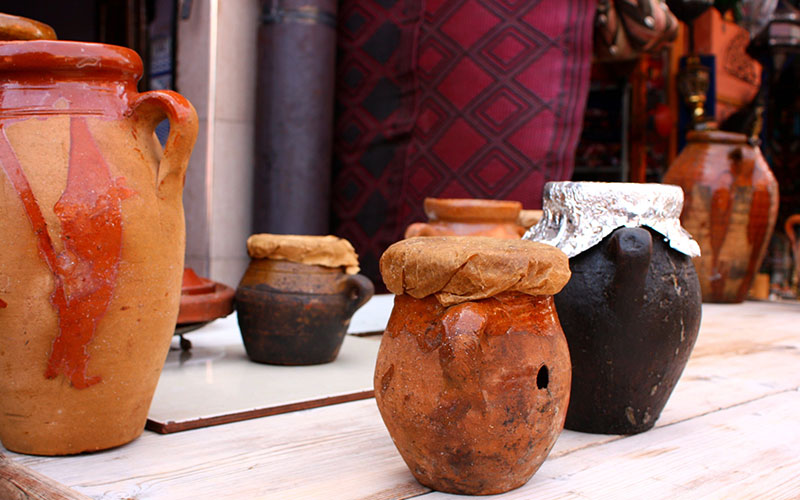
A tangia, a Moroccan amphora, serves as both a cooking vessel and the namesake for a confit-style stew, emphasizing communal dining without formalities.
Definition and Components of Tangia
Crafted from clay and resembling an urn, the tangia has ancient roots as an olive oil transport vessel since Roman times. Associated with working men, it shares slow-cooking similarities with the tagine but uniquely incorporates ashes for an extended cooking process, yielding a gelatinous texture.
The tangia experience in Marrakesh, accessible to cooks of all levels, often involves butchers managing ingredients. This approach allows for regional variations from sweet to tangy or savoury renditions.
Meat, Pulses, and Grains in Tangia
Traditionally, tangia embraces gelatinous and tender cuts like hock, collar, or a blend of calf parts. However, it’s versatile, allowing for the use of different meats such as rabbit, chicken, or lamb. Contemporary variations even introduce vegetarian and fish versions.
Incorporating Moroccan Sephardic culinary traditions, tangia may also include pulses and grains like wheat, beans, or chickpeas, often wrapped in muslin or cheesecloth, for a nod to historical cooking practices.
Liquid, Oils, Spices, and Condiments in Tangia
In the tangia, the French à l’étouffée method is employed with minimal liquid, crafting a confit-like texture. A careful blend of olive oil and Moroccan smen enhances the mingling of ingredients.
Savoury tangia is distinguished by saffron and generous ground cumin, while preserved lemons and garlic contribute depth. Sweet variations may introduce honey for a nuanced flavour profile.
Note: some versions of Tangia incorporate onions and potatoes, tangia is generally a vegetable-free dish catering to meat lovers. However, modern adaptations include vegetarian options.
Historical Context of Tangia
Originally a dish for working men, tangia is linked with craftsmanship cities like Marrakesh but extends to Meknes, Fez, Sefrou, and Taroudant. Artisans traditionally pooled resources for ingredients, delivering the tangia to a fernatchi for slow-cooking in communal ovens, culminating in a shared meal at lunchtime accompanied by mint tea.
How to Prepare and Cook Tangia
Ingredients of A Moroccan Tangia
4 pounds lamb or beef, cut into 4- to 5-inch pieces
– 1 medium onion, chopped
– 6 to 8 cloves garlic, chopped
– 1 large handful fresh parsley or cilantro, chopped
– 2 teaspoons ras el hanout
– 2 teaspoons cumin
– 1 1/4 teaspoons salt
– 1 teaspoon saffron threads, gently heated and crumbled
– 1 teaspoon turmeric
– 1 teaspoon ginger
– 1/2 teaspoon freshly ground black pepper
– 1/2 teaspoon freshly ground white pepper
– 1/2 preserved lemon rind, finely chopped
– 1/2 preserved lemon, cut into wedges
– 1/4 cup olive oil
– 3 to 4 tablespoons water
Cooking Method
1. Prepare Ingredients:
– Gather all the specified ingredients.
2. Mix and Transfer:
– In a bowl, mix the meat with chopped onion, garlic, parsley or cilantro, spices, and chopped preserved lemon rind.
– Transfer the seasoned meat mixture to the tangia (or another deep ovenproof cooking dish).
3. Add Remaining Ingredients:
– Add olive oil, preserved lemon wedges, and water to the tangia.
4. Cover and Seal:
– Cover the top of the tangia with a parchment paper circle slightly larger than the opening’s diameter.
– Layer aluminum foil over the parchment paper, wrapping and sealing it snugly to the tangia.
– Pierce the foil and parchment paper in 2 or 3 places with a fork.
5. Cooking Process:
– Place the tangia in a cold oven, set the thermostat to 275 F/140 C, and turn the oven on.
– Leave the tangia for 5 to 6 hours, periodically checking if the meat is sufficiently cooked. It should become tender and easily fall off the bone.
6. Serve:
– Serve the tangia on a large communal platter.
– Accompany it with Moroccan bread (khobz) for scooping up the flavorful meat and sauce.
A Tip for Tangia:
If your tangia doesn’t fit in your oven due to its height, try placing it on its side at an angle and supporting the top with bakeware, like an inverted loaf pan.
Recipe Variations: Cooking on the Stovetop
For an alternative method, cook tangia on the stovetop using a sturdy pot or pressure cooker. Adjust the water to 2 1/2 cups and simmer for 2 1/2 to 3 hours (keep an eye on the water level) or pressure cook for 1 hour until the meat effortlessly separates. Reduce the sauce until thickened before serving.


